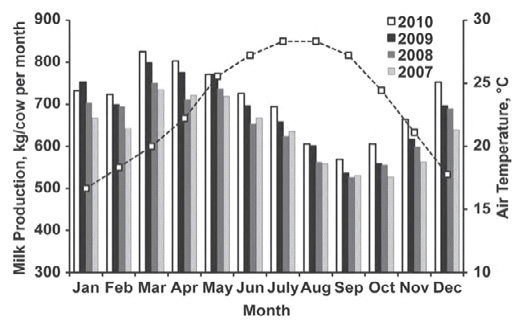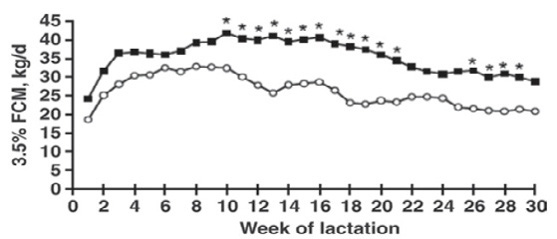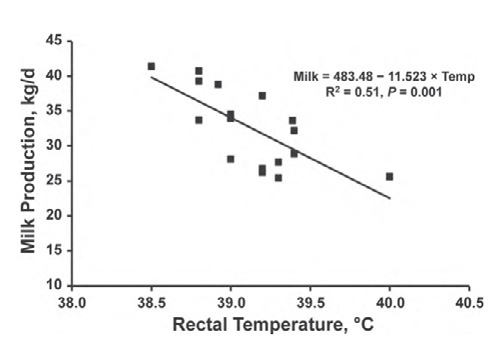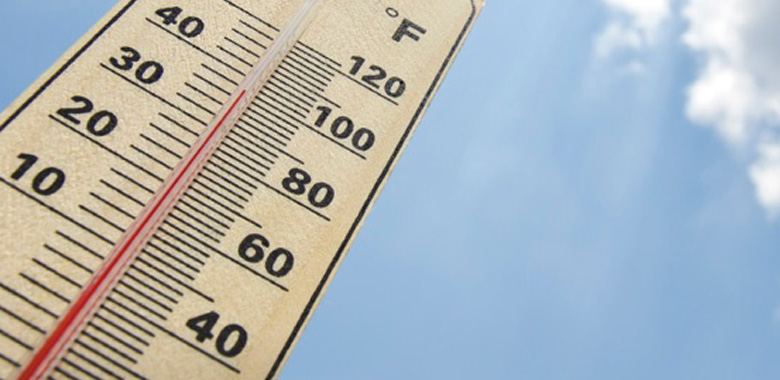The impact of summer heat stress on lactating cows is well known. However, less is known about the impact on dry cows. Figure 1 shows monthly average milk production in Florida during the years 2007 to 2010 (bar graphs) and the typical average ambient temperature in Okeechobee, Florida (dashed line). As expected, milk production begins dropping in the spring as ambient temperature rises. However, ambient temperature peaks by July–August but milk production does not begin to rebound until October–November. This delay in production recovery after heat stress is at least partially due to the poor performance of fresh cows in September and October that were dry during the high temperature period of July– August.

Figure 1. Tao and Dahl, 2013, JDS Amaral et al. (2009, JDS) evaluated the effect of cooling dry cows during the summer in Florida on their subsequent lactation performance. Dry cows were divided into two similar groups. One group was provided fans and sprinklers (COOL) and the other group was not (HOT). After calving, all cows were moved to the same lactation pen, which used fans and sprinklers for cooling. Results of cooling cows during the dry period are shown in Table 1.
| HOT | COOL | P= | |
| Rectal Temperature, F° | |||
| AM | 101.7 | 101.5 | .35 |
| PM | 102.6 | 101.8 | .05 |
| Days Dry, d | 38 | 45 | .12 |
| Calf birth weight, lb | 68.2 | 96.8 | <0.001 |
| Cow body weight, lb | 1393 | 1536 | 0.01 |
| Dry Matter Intake, lb/d | |||
| Prepartum | 26.4 | 31.0 | 0.001 |
| Postpartum | 42.5 | 38.9 | 0.36 |
Subsequent production of the cows, after they freshened and were cooled with sprinklers and fans, shows a significant difference due to if they were cooled or not cooled during their dry period (Figure 2). The degree of depressed milk production is strongly related to the heat load or elevated body temperature experienced by cows in late gestation (Figure 3).

Figure 2. Production of cows cooled (■) or heat stressed (○) during a 46-d dry period and then housed together in the same barn equipped with fans and sprinklers after parturition. *P < 0.05. (Amaral et al., 2009, JDS)

Figure 3. Scatter plot of relationship between afternoon rectal temperature (°C; Temp) of cows during late gestation and daily milk production (kg/d) in the subsequent lactation. Data were obtained from published papers (Collier et al., 1982b; Wolfenson et al., 1988; Avendano-Reyes et al., 2006; Adin et al., 2009; do Amaral et al., 2009, 2011; Tao et al., 2011, 2012b; Thompson et al., 2012).
Several factors influenced by heat stress in the dry period may be reducing later milk production. These factors include lower DMI, shorter gestation period, and higher levels of plasma prolactin. Tao, et al., (2011) observed lower mammary epithelial cell proliferation rates during the dry period when cows were heat stressed vs cooled and suggested this was due to the higher levels of prolactin in the heat stressed cows. Lower rates of mammary cell proliferation and a shorter dry period may result in less mammary secretory tissue development for milk synthesis during the subsequent lactation. Ramirez-Lee et al. (2015) found that heat stress in the early portion of the dry period reduced mammary involution— an important physiological process in preparation for the subsequent lactation. A summary by Tao et al. (2016) of heat stressed vs cooled dry cows during summer months revealed that cooling cows only in the close-up dry period improved milk production by an average of 6% in the following lactation, but cooling cows the entire dry period improved milk production by an average of 12%.
The bottom line is that it pays to extend the use of heat abatement practices (shade, fans, sprinklers, or misters) to all dry cows as well as lactating cows. Including I.C.E.™ in the dry cow ration also is valuable to minimize elevated body temperatures due to summer heat stress.
This article first appeared in Perspectives Magazine Spring 2016 issue.

